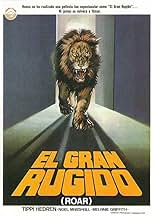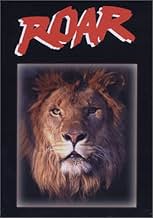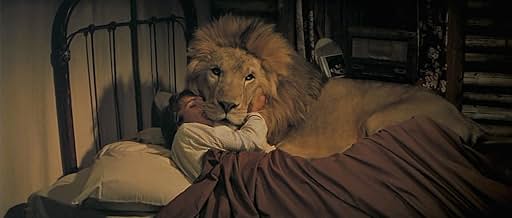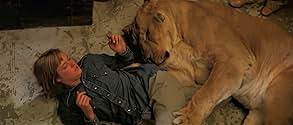Roar
- 1981
- Tous publics
- 1h 35m
A naturalist living with big cats in East Africa expects a visit by his family of four from Chicago. A mix-up leaves him searching for his family, who have been left in the clutches of wild ... Read allA naturalist living with big cats in East Africa expects a visit by his family of four from Chicago. A mix-up leaves him searching for his family, who have been left in the clutches of wild lions.A naturalist living with big cats in East Africa expects a visit by his family of four from Chicago. A mix-up leaves him searching for his family, who have been left in the clutches of wild lions.
Zakes Mokae
- Committee Member
- (as Zakes Moakae)
- Director
- Writers
- All cast & crew
- Production, box office & more at IMDbPro
Featured reviews
Noel Marshall and Tippi Hedren certainly had a, uh, interesting relationship for a while there in the 70's and early 80's. I don't know what their marriage was like behind closed doors of course, but somehow it's a great gift to the Earth that they produced the film ROAR. Why this is can't be easily explained in a review, but I can try with this: it's about a family that lives with lions and tigers and some elephants and panthers too. Or rather it's about a guy who LOVES these lions and tigers (by the way, why tigers, shouldn't they be in India and, oh, nevermind) and panthers and so on, and invites his wife to come live with him along with her and his kids. So here comes Tippi Hedren and actual real life children Melanie Griffith and John and Jerry (Marshall's kids), and when they arrive Noel is out uh doing stuff out in the plains or jungle, and they have to contend with a house full of lions. Oh, and these were UNTRAINED LIONS by the way.
In a way I should be critical of Roar. Marshall, with the exception of one sequence that takes on the qualities of a Night of the Living Dead picture with wild cats in place of the un-dead, doesn't really set up suspense very well. The fascination with watching Roar is basic but constant: these are real people, many of them likely not exactly used to the f***ing idea of hanging out with things like lions and tigers, being knocked around, chased, bombarded by their paws and jaws and bodies, and that should in all likelihood they could/should kill these people.
There's also the behind the scenes drama that imbues real danger with what's on screen so much; right on the cover of the blu-ray it states that 70 cast/crew were harmed, and looking up who got what is just staggering (to give you an idea of the extent, director of photography Jan de Bont got his skull practically knocked off, and Melanie Griffith got facial reconstructive surgery, though the fact that we didn't notice in those movies she starred in in the 80's shows how good that surgery must have been). If there was a documentary on the making of this film it might make Herzog's Grizzly Man look like kids stuff.
Indeed the hero to me of this film is de Bont; he gets his camera into places that I just couldn't think would be possible, right in the faces of these lions, capturing action that seems impossible - certainly with the knowledge that these lions didn't have proper, you know, TRAINERS. It's just a feeling of constant WTF that goes on with this - likely why it got picked up by Drafthouse Films as Drafthouse CEO Tim League is all about finding the freshest and brightest of those WHAT IS THIS sort of flick (they also released Miami Connection some years back) - and it's amazing just on that basis alone. It's also just hysterically funny in that way that the movie lacks that awareness of the danger. Or, let me rephrase that, I think the director knew that there would be danger with these cats, but, well, why carp? The attitude is that Man is the biggest enemy - the closest thing to antagonists are under-developed hunters, you know they are as they get lines showing that I guess and they have the guns - and that, with the exception of one memorable/super-bloody lion named Togar, the lions would be just peaceful and lovable creatures if left alone.
But the ethos of the filmmakers is constantly at odds with what IS shown on screen. The actors, to their credit (at least Hedren and Griffith to an extent), get this and play this fear well through a long mid-section. There's really the feeling like there isn't really any, shall we say, 'acting' going on here; to this end, Melanie is named Melanie as are the Marshall sons, though why Hedren is a different character name is anyone's guess. I'd be surprised if there even was a solid script - how do you get these lions et al to do the things they do? It's an entirely maddening enterprise to see unfold, the kind of movie that shouldn't have been made, and may even be (borderline?) unethical, but as it is here you can't look away from the metaphorical train-wreck.
In a way I should be critical of Roar. Marshall, with the exception of one sequence that takes on the qualities of a Night of the Living Dead picture with wild cats in place of the un-dead, doesn't really set up suspense very well. The fascination with watching Roar is basic but constant: these are real people, many of them likely not exactly used to the f***ing idea of hanging out with things like lions and tigers, being knocked around, chased, bombarded by their paws and jaws and bodies, and that should in all likelihood they could/should kill these people.
There's also the behind the scenes drama that imbues real danger with what's on screen so much; right on the cover of the blu-ray it states that 70 cast/crew were harmed, and looking up who got what is just staggering (to give you an idea of the extent, director of photography Jan de Bont got his skull practically knocked off, and Melanie Griffith got facial reconstructive surgery, though the fact that we didn't notice in those movies she starred in in the 80's shows how good that surgery must have been). If there was a documentary on the making of this film it might make Herzog's Grizzly Man look like kids stuff.
Indeed the hero to me of this film is de Bont; he gets his camera into places that I just couldn't think would be possible, right in the faces of these lions, capturing action that seems impossible - certainly with the knowledge that these lions didn't have proper, you know, TRAINERS. It's just a feeling of constant WTF that goes on with this - likely why it got picked up by Drafthouse Films as Drafthouse CEO Tim League is all about finding the freshest and brightest of those WHAT IS THIS sort of flick (they also released Miami Connection some years back) - and it's amazing just on that basis alone. It's also just hysterically funny in that way that the movie lacks that awareness of the danger. Or, let me rephrase that, I think the director knew that there would be danger with these cats, but, well, why carp? The attitude is that Man is the biggest enemy - the closest thing to antagonists are under-developed hunters, you know they are as they get lines showing that I guess and they have the guns - and that, with the exception of one memorable/super-bloody lion named Togar, the lions would be just peaceful and lovable creatures if left alone.
But the ethos of the filmmakers is constantly at odds with what IS shown on screen. The actors, to their credit (at least Hedren and Griffith to an extent), get this and play this fear well through a long mid-section. There's really the feeling like there isn't really any, shall we say, 'acting' going on here; to this end, Melanie is named Melanie as are the Marshall sons, though why Hedren is a different character name is anyone's guess. I'd be surprised if there even was a solid script - how do you get these lions et al to do the things they do? It's an entirely maddening enterprise to see unfold, the kind of movie that shouldn't have been made, and may even be (borderline?) unethical, but as it is here you can't look away from the metaphorical train-wreck.
You know what? Sometimes words really aren't enough to do justice to something.
Roar has to be without a doubt the most insanely unsafe cinematic undertaking I have ever had the pleasure of watching. The unbelievably high level of danger is quite frankly there for everyone to see up on the screen as we watch a group of actors interact with over one hundred big cats with no protection whatsoever! It was inspired by the success of the lion drama Born Free (1966). And you might make the observation that there is fifteen years between these two movies and think this strange, well that's because this flick took eleven years from start to finish! Its production met with all manner of set-backs such as fire, flood and disease; each of which put the film's schedule back. But more to the point, it was as dangerous to work on as it looks on screen. The opening credits state that no animals were hurt in the making of the film, what they could not say with as much confidence was that there were no humans hurt! As it was, seventy cast and crew were injured, including cinematographer Jan de Bont who was partially scalped, Tippi Hedren had her neck bitten, Melanie Griffiths almost lost an eye, Jerry and John Marshall both required extensive stitches, while Noel Marshall was attacked so often it took years for him to recover from his injuries. When you watch Noel in action in this film it is not exactly hard to see why! In fact some of the injuries can be seen happening on screen. It is madness, pure and utter madness.
But because of this, it makes for highly entertaining and bizarre viewing. Unfortunately, the public back in 1981 didn't seem to agree and Roar was a box office disaster. To be honest, this is not entirely surprising as this feels far more like a cult movie than blockbuster material, given its utter strangeness. For a start it doesn't really have a plot and it boils down to a few events that bring our human cast into contact with the big cats. The story barely makes sense if you think about it very long. But who needs a story when you've got this insanity on screen? The madness and health and safety black hole that the events on screen represent mean that a story needs be no more than an afterthought. For what it's worth, Noel Marshall - wrote, starred, directed and financed it and his wife Tippi Hedren, who was a wildlife activist who campaigned for the protection of big cats, was the big name draw. Hedren, of course, was previously most well-known for her starring role in The Birds (1963) where she was famously mauled and scratched by an assortment of flying fiends. Well, all I can say is that what she experiences on Roar makes the actions of the birds in Alfred Hitchcock's classic seem positively reticent by comparison.
The actors are all splendidly game and deserve huge amounts of credit for their nerve but the real stars of Roar are the big cats and rampaging elephants. This is the ultimate wet dream for any lover of the big cats in particular and we have the very strange scenario of seeing lions, cheetahs, panthers, leopards and tigers interacting with each other. Watching them violently wrestle is a pretty nerve shredding thing, except if you are Noel Marshall that is, he usually runs in to join them! But on the whole, while there are a few continuity errors and the editing is full-on and sporadic, this is exciting stuff that could never in a million years be described as boring. It truly defines the term 'one of a kind'. With health and safety legislation what it is now, there is no way in hell there will ever be another film like Roar. It's truly unique and I sure lapped it up.
Roar has to be without a doubt the most insanely unsafe cinematic undertaking I have ever had the pleasure of watching. The unbelievably high level of danger is quite frankly there for everyone to see up on the screen as we watch a group of actors interact with over one hundred big cats with no protection whatsoever! It was inspired by the success of the lion drama Born Free (1966). And you might make the observation that there is fifteen years between these two movies and think this strange, well that's because this flick took eleven years from start to finish! Its production met with all manner of set-backs such as fire, flood and disease; each of which put the film's schedule back. But more to the point, it was as dangerous to work on as it looks on screen. The opening credits state that no animals were hurt in the making of the film, what they could not say with as much confidence was that there were no humans hurt! As it was, seventy cast and crew were injured, including cinematographer Jan de Bont who was partially scalped, Tippi Hedren had her neck bitten, Melanie Griffiths almost lost an eye, Jerry and John Marshall both required extensive stitches, while Noel Marshall was attacked so often it took years for him to recover from his injuries. When you watch Noel in action in this film it is not exactly hard to see why! In fact some of the injuries can be seen happening on screen. It is madness, pure and utter madness.
But because of this, it makes for highly entertaining and bizarre viewing. Unfortunately, the public back in 1981 didn't seem to agree and Roar was a box office disaster. To be honest, this is not entirely surprising as this feels far more like a cult movie than blockbuster material, given its utter strangeness. For a start it doesn't really have a plot and it boils down to a few events that bring our human cast into contact with the big cats. The story barely makes sense if you think about it very long. But who needs a story when you've got this insanity on screen? The madness and health and safety black hole that the events on screen represent mean that a story needs be no more than an afterthought. For what it's worth, Noel Marshall - wrote, starred, directed and financed it and his wife Tippi Hedren, who was a wildlife activist who campaigned for the protection of big cats, was the big name draw. Hedren, of course, was previously most well-known for her starring role in The Birds (1963) where she was famously mauled and scratched by an assortment of flying fiends. Well, all I can say is that what she experiences on Roar makes the actions of the birds in Alfred Hitchcock's classic seem positively reticent by comparison.
The actors are all splendidly game and deserve huge amounts of credit for their nerve but the real stars of Roar are the big cats and rampaging elephants. This is the ultimate wet dream for any lover of the big cats in particular and we have the very strange scenario of seeing lions, cheetahs, panthers, leopards and tigers interacting with each other. Watching them violently wrestle is a pretty nerve shredding thing, except if you are Noel Marshall that is, he usually runs in to join them! But on the whole, while there are a few continuity errors and the editing is full-on and sporadic, this is exciting stuff that could never in a million years be described as boring. It truly defines the term 'one of a kind'. With health and safety legislation what it is now, there is no way in hell there will ever be another film like Roar. It's truly unique and I sure lapped it up.
Although it is no Disney classic, Roar is a tale of adventure well worth watching. I am a huge fan of films that take me to the far reaches of the world, and, in that regard, this is a movie that delivers. The lions are incredible and the filmmakers exhibit a thorough understanding of who the real stars of the show are. The lions take center stage and shine. The performances by the cast are competent, but I am an animal lover and for me, that is the true draw of the film.
I first saw this in the early 90s on a vhs. Revisited it recently with my 7 year old nephew.
While i found it a bit tedious now, my nephew enjoyed it.
The film doesn't have any plot n it has lots of hide n seek kinda moments. It is funny at times, the scene where the lioness try the skateboard, the facial expression of the big cat when a leopard grabs away the meal, the cat pushing the female in the water, etc.
The film is very picturesque.
I found Tippi Hedren at 51 in this film very attractive n in good shape.
I saw this movie dubbed in German in 1984 and thought it was incredible how lions were used in the movie. The plot, though simple, is interesting which makes the movie enjoyable for a wide audience. The writers did a good job in keeping the humor light. Kudos go to the lead characters in the movie, supposedly some of whom got injured in the filming.
Did you know
- TriviaMost of the lion attacks were real, and usually resulted in actual injury to the cast and crew.
- GoofsAfter Hank goes to the airport to get his family, on his return trip, he picks up Mativo and the tigers. Mativo's bike is placed in the trunk with the front wheel hanging out. Further down the road, the trunk is closed with no bike hanging out. Still further, the bike is again hanging out.
- Crazy creditsOpening credits features this text: "Since the choice was made to use untrained animals and since for the most part they chose to do as they wished, it's only fair they share the writing and directing credits."
- Alternate versionsIn Australia, two versions of the film were shown theatrically. In 1982, a year after the original film received an NRC (PG equivalent) rating, the film was re-released in an edited G-rated version advertised as being "for the whole family".
- ConnectionsFeatured in The Making of Roar (2004)
Details
- Release date
- Country of origin
- Official site
- Language
- Also known as
- El gran rugido
- Filming locations
- Shambala Preserve, 6867 Soledad Canyon, Acton, California, USA(Chief location)
- Production companies
- See more company credits at IMDbPro
Box office
- Budget
- $17,000,000 (estimated)
- Gross US & Canada
- $110,048
- Opening weekend US & Canada
- $15,064
- Apr 19, 2015
- Gross worldwide
- $110,449
- Runtime
- 1h 35m(95 min)
- Color
- Sound mix
- Aspect ratio
- 2.39 : 1
Contribute to this page
Suggest an edit or add missing content
















